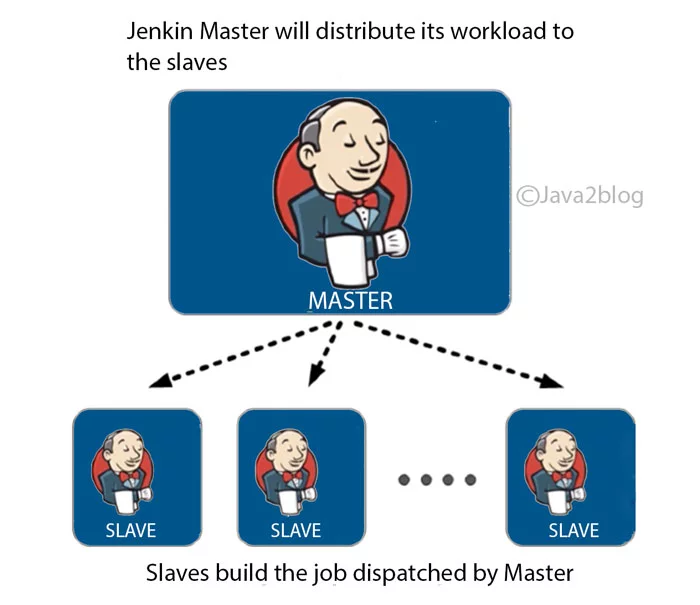Jenkins Architecture
Jenkins Architecture
Jenkins architecture supports continuous integration and delivery through automation.
-
Scalable Design
- Utilizes a master-slave setup.
- Distributes tasks for better efficiency.
-
Plugin Support
- Offers extensive plugins for integration.
- Enhances functionality and customization.

Master Node
The master node orchestrates the build process and manages configurations.
-
Job Management
- Schedules and executes jobs.
- Manages builds and tests.
-
User Interface
- Provides a web-based management interface.
- Allows users to configure jobs and view statuses.
Slave Node
Slave nodes execute tasks assigned by the master node, distributing workloads.
-
Parallel Execution
- Runs multiple builds simultaneously.
- Reduces overall build time.
-
Resource Utilization
- Efficiently uses separate machines for tasks.
- Frees the master node for management duties.
Components of Jenkins
-
Job/Project
- Represents a single task to be executed.
- Can be configured for builds, tests, and deployments.
-
Slave/Node
- Executes jobs sent by the master node.
- Helps distribute workload for efficiency.
-
Executor
- A computational resource for executing builds on a node.
- Each node can have multiple executors for parallel processing.
Executor
An executor is a crucial component in Jenkins that enables builds to run on nodes efficiently.
- Represents a resource unit for executing builds on a node.
- Indicates the maximum number of concurrent builds.
- Set the number of executors to match CPU cores for optimal performance.
- More executors can increase throughput but may lengthen individual build times.
- Enables simultaneous CPU-bound and I/O-bound builds for better resource use.
Label Nodes
In certain scenarios, specific nodes may be reserved for particular job types.
- For example, performance tests might need a dedicated machine.
- Label test jobs to restrict them to specific machine.
- Labeling prevent other jobs from using the test jobs
Build Steps and Build Triggers
Build steps define the actions taken during a build process, while build triggers determine when builds are initiated.
-
Build Steps
- Specify actions like compiling code and running tests.
- Can include scripts, commands, or plugins.
-
Build Triggers
- Automate build initiation based on events, such as code commits.
- Supports scheduled builds and manual triggers.
For more information, please see Jenkins Build Triggers.
Artifacts and Repositories
Artifacts are the files produced from a build process, while repositories store these files for access and version control.
-
Artifacts
- Generated outputs, such as compiled code and packages.
- Can be stored for future deployment or reference.
-
Repositories
- Centralized storage for artifacts and versioned code.
- Facilitates collaboration and access across teams.
Build Tools
Build tools automate the process of compiling and packaging code for deployment.
-
Automation
- Streamlines the building process to improve efficiency.
- Reduces manual errors and speeds up delivery.
-
Integration
- Works seamlessly with Jenkins to manage builds.
- Supports various programming languages and frameworks.
Testing and Notifications
Testing ensures that code quality is maintained, while notifications keep the team informed about build statuses.
- Verifies that the code functions as intended through automated tests.
- Helps catch bugs early in the development cycle.
Notifications provide real-time updates on build statuses, ensuring the team is informed.
- Alerts the team about successful or failed builds.
- Can be sent via email, messaging apps, or dashboards.
There are different tests developers can run on their code:
- Unit Test
- Smoke Test
- Functional Test
- Acceptance Test
For more information, please see Types of Tests.